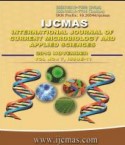


 National Academy of Agricultural Sciences (NAAS)
National Academy of Agricultural Sciences (NAAS)

|
PRINT ISSN : 2319-7692
Online ISSN : 2319-7706 Issues : 12 per year Publisher : Excellent Publishers Email : editorijcmas@gmail.com / submit@ijcmas.com Editor-in-chief: Dr.M.Prakash Index Copernicus ICV 2018: 95.39 NAAS RATING 2020: 5.38 |
The present study was carried out in a continuing experiment at the Bhadiarkhar farm of the CSK HPKV. Eight cropping sequences [C1- ‘rice – wheat’, C2- ‘rice – pea – summer squash’, C3- ‘okra – radish – onion’, C4- ‘turmeric – pea – summer squash’, C5- ‘rice – lettuce – potato’, C6- ‘rice – palak – cucumber’, C7- ‘rice – broccoli – radish’, C8- ‘colocasia – pea + coriander’] were evaluated during 2016-17. There were 24 weed species which invaded different cropping systems. During kharif, Ageratum sp. (28%), Cynodon dactylon (20%) and Commelina benghalensis (19%) were the predominant weeds. In rabi, Phalarisminor (63%) was the most dominating weed followed by Coronopus didymus (10%) and Spergulla arvensis (6%). In kharif, weed flora was more diverse in C3, C4 and C8 i.e. okra, turmeric and colocasia based sequences, respectively and weed diversity was lower in rice-based sequences. In rabi, highest diversity of weed species was in rice-wheat sequence.C8 had highest RGEY among all the crop sequences. Weeds inflicted huge yield losses ranging from 30.6 in C1 to 59.2% in C6. N depletion by weeds ranged from 16.2 in C6 to 48.5 kg/ha/annum in C3, P from 3.1 in C5 to 8.1 kg/ha/annum in C3 and K from 4.8 in C6 to 13.2 kg/ha/annum in C3.
 |
 |
 |
 |
 |